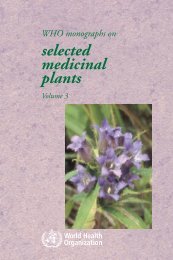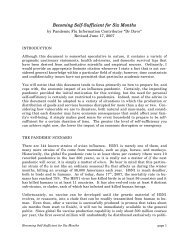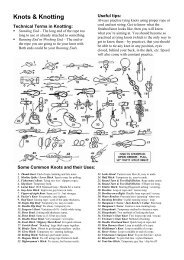Create successful ePaper yourself
Turn your PDF publications into a flip-book with our unique Google optimized e-Paper software.
COMMON EDIBLE MUSHROOMS<br />
nature incomprehensible! This is a mushroom all should know<br />
(Figure 21 and Plate 2A), since it is very common, growing in<br />
bright reddish brown clumps out of old branch stubs and wounds<br />
on shade and forest trees. It is one of the first to appear in the spring<br />
and one of the last to disappear in the fall. In fact, it is so tenacious<br />
of life that individuals emerging in late autumn may endure<br />
through the winter, even in severe climates, and on warm January<br />
days they will pop up in all their colorful freshness, leading<br />
those who do not know the habits of the species to believe that the<br />
fruit body has developed in the dead of winter.<br />
The caps are at first reddish brown, later tan, and in moist<br />
weather they will shine with a light reflected from their sticky,<br />
gelatinous surface. Fully expanded caps vary from i 1/2 to ^3<br />
inches in diameter. The gills are white, narrow, and close together.<br />
The stems are from 1/4 to 1/2 inch in diameter and 2 to 5 inches<br />
long, several or many arising from the same spot and curving outward<br />
and upward. When young they are somewhat paler than the<br />
caps and tinged with yellow, but as they age they become covered<br />
toward the base with a dense, velvety pile of reddish brown hairs.<br />
The edibility of this plant is excellent — which may in part condone<br />
the damage it does by rotting the interior of our trees. Basswood<br />
is a favorite host, but it is found on other hardwoods also.<br />
GENUS Lactarius<br />
This genus is normally one of the most easily recognized, for the<br />
name, meaning milky, is descriptive of the white or colored juice<br />
that exudes from the flesh of the cap or gills when they are broken.<br />
In dry weather this telltale juice may be scanty or even wanting<br />
altogether in some species, but if so-called mushroom weather<br />
prevails, one need only bend back the cap enough to break the<br />
edges of a few gills in order to see the bead-like drops of juice<br />
ooze out. Subjected to such a test, a mushroom that exudes droplets<br />
of a white or colored liquid is invariably Lactarius, although, as<br />
stated above, a Lactarius does not always provide this evidence of<br />
its identity.<br />
48
















